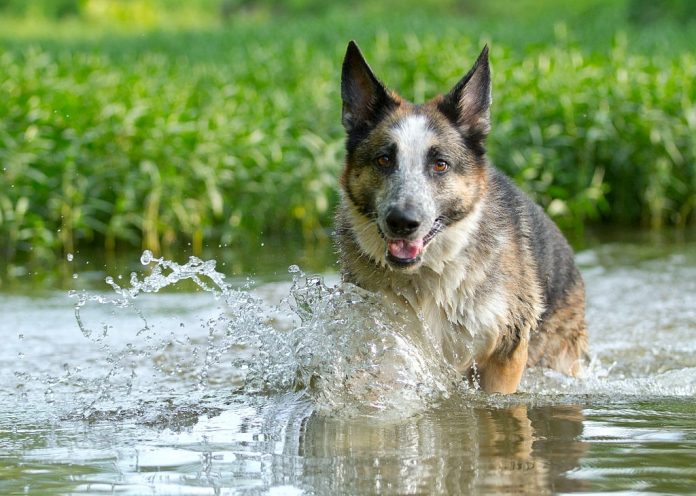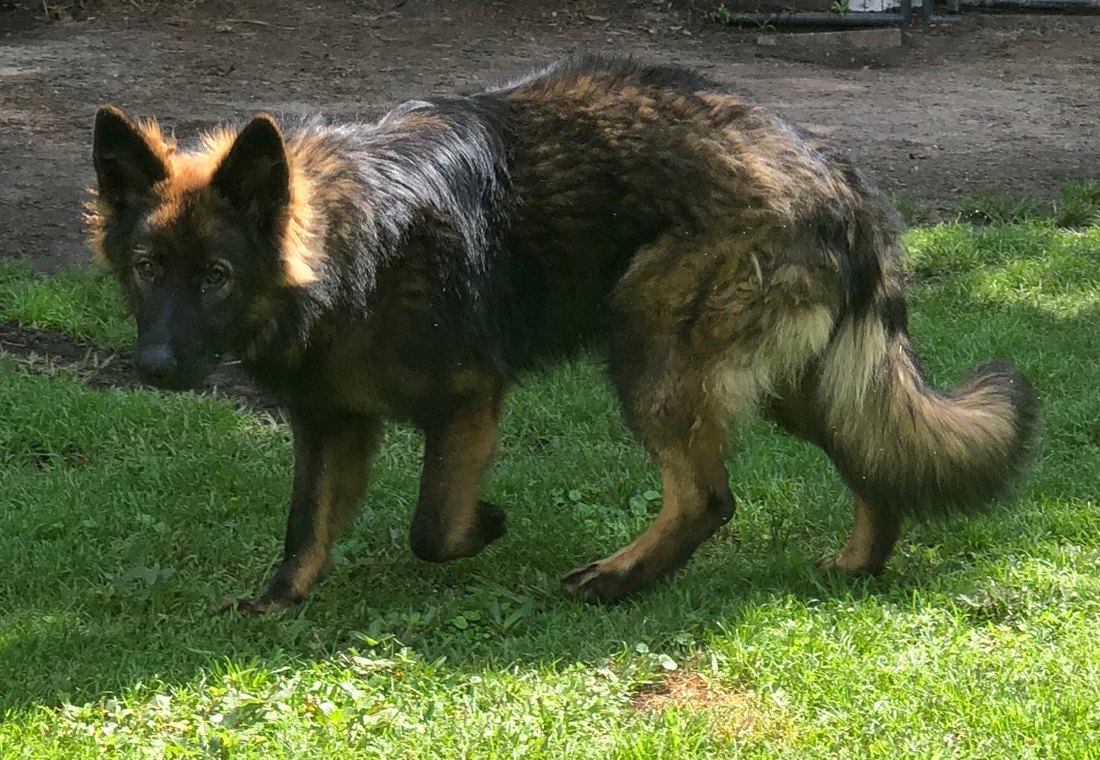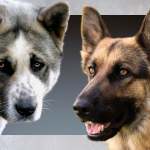Among all the dogs related to the German Shepherd, or variants of this breed, the Blue Panda German Shepherd is perhaps the most beautiful wonder; this little creature is the result of a genetic mutation that gives it that appear so similar to a piebald teddy bear so unique, and that makes it different from all the others.
Despite his beauty, he is still a full-fledged shepherd. Strong agile and intelligent, this variety of the German Shepherd is a great companion and helper in life, an exceptional protector. Its greatest attribute is that color product of a mixture of white, black, and tan, which makes it that precious miracle of nature.
What Are Blue Panda German Shepherds?
Contents
- 1 What Are Blue Panda German Shepherds?
- 2 History Of Blue Panda German Shepherd
- 3 Are Blue Panda German Shepherds Rare?
- 4 Are The GSD Blue Panda Different From Other Breeds?
- 5 Appearance Of Blue Panda German Shepherds
- 6 Health Issues
- 7 How To Care For Blue Panda German Shepherds
- 8 How To Train the Blue Panda GSDs?
- 9 What Is The Personality Of A Blue Panda German Shepherd Like?

The history of this variety of shepherds goes back to the first specimen to be named Franka. His parents, certified as police dogs, were tough and tough. Franka’s mutation left her breeder astonished, given the beauty of her coloration. The studies carried out discovered that this specimen’s particularity resulted from a mutation of the KIT gene, which is responsible for controlling cellular functions. This gene affected the color of the coat resulting in that unlikely combination of colorations.
While genetic mutations are known to cause a change in eye coloration or white patches on the coat. However, in this case, the coloration was mixed, giving rise to a new tonality and spots in these breeds. The white spots are not the same as those of other races.
Regarding its appearance, its body is robust, muscular, and slightly elongated. Its head is always proportional to its body and slightly rounded. Their nose is black or blue, but the latter is much rarer. Their teeth are strong, and their eyes are almond-shaped and dark in color.
Their temperament makes them an excellent working dog. They are alert, enthusiastic, cheerful, bold, eager to learn, obedient, confident, calm, intelligent, and serious; they are excellent at learning and extremely faithful and courageous.
History Of Blue Panda German Shepherd
If we trace the lineage of the panda herders, we will find our grandfather Beawolf. Honor Von Grafath was able to sire more than 100 panda herders, many by consanguinity.
If we go back to a much more recent line, we can find that Cindy Whitaker could inadvertently raise the first panda registered in 2000 in the United States. Son of Brain vom Wölper Löwen SCHH III, a black and tan specimen, and of Cynthia Madchen Alspach, the mother of his black shepherd.
The color of these dogs is a diluted version, so to speak, of the Black Shepherd. The dilution den Dd mainly affects the color of the coat, the eyes, or the nose. A group of genes controls all the colors of the layers.
A set or group of genes controls all coat colors and patterns. However, in this hybrid, the coloration is controlled by the D gene. This gene is present in all German Shepherd breeds and is responsible for the coloration. Black when active, diluted when inactive. Its rarity is because for a specimen to be born, two inactive genes are required. These dogs can have three types of blue coloration: blue and black, blue and sable, and blue and tan.
Are Blue Panda German Shepherds Rare?
Yes, Blue Panda German Shepherds are a rare genetic mutation that does not occur in all litters and is considered a dilution of the gene for black coloration. Even if both parents are of the same variety, D may not be evident or passed on if both parents do not have the gene. Although this is very rare, as this gene is extremely dominant, it only appears in one individual in the entire litter. It is said that only one out of a thousand specimens of German Shepherds is usually a panda.
Are The GSD Blue Panda Different From Other Breeds?
Only in appearance could we tell their difference. Blue Panda shepherds do not have characteristics that distinguish them beyond the color of other dog breeds. On average, they are German Shepherds from the same family and have the same characteristics as their predecessors’ mixes.
Appearance Of Blue Panda German Shepherds

Only the color of its coat differentiates it from the rest of the German Shepherds. It is equal to any of the families of this formidable race regarding its physical structure and complexion.
- Weight: Males are in the 65 to 90-pound range, with a cross measurement, from the paw to the shoulder, 24 to 26 inches. For their part, the females will be in the range of 50 to 70 pounds. And across measurements of between 22 to 24 inches.
- Color: dogs may have a coat that is not necessarily blue, which would be the most common, however gray, sable, white, black, and some combinations such as black and red may appear.
- Eyes: The Blue German Shepherd has a lighter eye coloration, blue or golden brown or yellow, compared to other German Shepherds.
Health Issues
There is no evidence to determine any relationship between the gene mutation and any genetic or degenerative disease. In these dogs, they are the same as any German shepherd, so their conditions and health problems are the same.
- Hip dysplasia: all German Shepherds can suffer from this condition due to wear and tear on the hip bones. It is usually caused by excessive exercise and age.
- Glaucoma: It is a disease manifested by an inflammation in the eyeball produced by an abscess or tumor’s growth. It is not a disease directly related to its breed. However, any dog is prone to suffering from it.
- Viral infections such as canine Parvovirus cause symptoms such as vomiting, diarrhea, and even bleeding, and if not treated in time, can be fatal. Like the previous one, distemper is a viral disease and is evidenced by symptoms such as cough, dyspnea, mucus, conjunctivitis, fever, and decay. All breeds of dogs are prone to this disease.
- Other diseases of bacteriological origin, such as leptospirosis, canine brucellosis, mastitis, pyometra, pododermatitis, demodectic mange, sarcoptic mange, are common in many dogs but are not directly related to the breed but the environmental factor and hygiene habits.
Also Read: White German Shepherd
How To Care For Blue Panda German Shepherds
All German Shepherds need space and exercise. They are strong and very active large dogs, so keeping them locked up in confined spaces is not a good idea.
- Hygiene: being dogs with a very abundant coat, their hygiene must be periodic. You should not let a lot of dirt accumulate so that it does not contract skin diseases.
- Training and exercise: Dogs, regardless of their breed, need to exercise frequently. The German Shepherd needs a lot of exercise; long walks can be very good for them. However, it should not be abused because they are prone to injuring their hips over the years.
- A safe space for them: These dogs are territorial and like to have their own spaces. Although you should not let them take over any flirt, it is always good that you keep an area where they can be free and without any restrictions.
How To Train the Blue Panda GSDs?
Positive reinforcement is always the best way to encourage learning. However, if you do not have any dog training experience, the best recommendation is to go to a professional school.
- Reward his obedience: if he has done what you ordered, reward him; It can be food, a treat, or just a gesture of approval.
- German Shepherds are rarely very social animals outside of their pack circle, and the family is their pack. So it is good that you try to keep him in contact with strangers, always under supervision.
- Do not let him take spaces that do not correspond to him. Remember that they are hunting dogs, so if there are small pets, you may see them as prey rather than companions. However, they are usually very protective.
- Regular exercise is the best way to keep them healthy, strong, and healthy. In conjunction with excellent nutrition, exercise will keep you calm and strong.
What Is The Personality Of A Blue Panda German Shepherd Like?
All German Shepherds are loyal and protective dogs. However, we must not forget that they have something of a wolf inside them, so we must respect their wild and aggressive side.
- Temperament: this quality will always depend on its direct ancestors (parents); however, German Shepherds are generally very obedient and loyal. Commonly, they generate a very strong attachment to their owners, which is very good in times of real danger. Still, being a very nervous breed, they can misinterpret any situation and attack.
- They do not respond well to the environment when they are new. They need to become familiar with their environment and with people. They are a bit suspicious due to their nervous nature. However, they are very faithful and obedient.
- It is not unusual to find some disasters. These dogs are energetic, and if not under supervision, they can get into some mischief.




